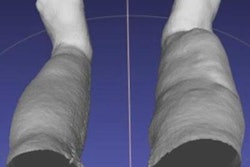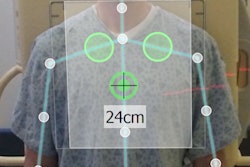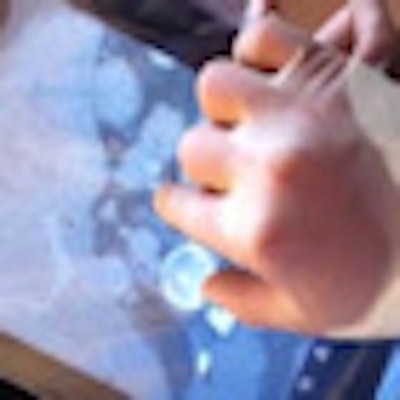
Microsoft's Kinect motion-sensing technology, Apple's iPad, and a motion-sensing device similar to those used in gaming consoles could all be used to review real-time intraoperative images in the interventional radiology suite, according to research from the University of California, San Diego (UCSD).
The UCSD team asked 29 radiologists to simulate intraoperative image review tasks using the three devices and found favorable results with each.
"Most surveyed radiologists foresaw that each of these devices could be useful for intraoperative use, and most believed that there were no issues with preserving the sterile field," said Dr. Cherng Chao, a fourth-year resident at UCSD Medical Center. He presented the findings during a scientific session at RSNA 2012.
Intraoperative image review is challenging due to the special requirements of the interventional environment. Not only are the findings important, but the review process must be efficient and the sterile field preserved, Chao said.
However, instructing a third party for help in reviewing images can be difficult, and the standard computer keyboard and mouse combination is cumbersome, not designed for intraprocedural use, and has been shown to harbor high rates of infectious colonization, Chao said.
Following up on prior work that showed potential for Kinect to help interventionalists view and manipulate intraoperative images in real-time without having to "scrub out," the team sought to determine the utility of Kinect, the iPad, and the Hillcrest Labs Loop Pointer, a device that uses gyroscopic sensors similar to those in Nintendo's Wii. The researchers also wanted to know if use of the devices could preserve the sterile field.
The Kinect device required the development of customized software to be able to interact with the Mobile MIM image viewing software (MIM Software) running on a laptop. This software development was led by co-author Dr. Justin Tan, a third-year resident.
The Loop Pointer and iPad were both enclosed in a plastic bag to simulate an operating environment.
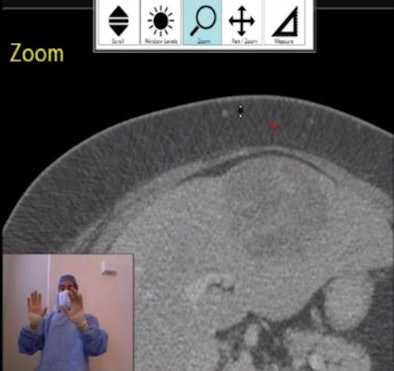 |
| Screenshot shows third-year radiology resident Dr. Justin Tan demonstrating Kinect for intraoperative imaging review. The mouse cursor (red cursor) can be directed with gesture commands. In this case, Tan is using the zoom function to magnify the liver lesion. An enlarged toolbar is at the top of the display. All images courtesy of Dr. Cherng Chao. |
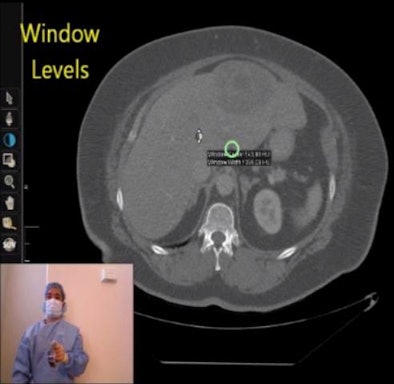 |
| Screenshot shows the Hillcrest Labs Loop Pointer for intraoperative imaging review. Users can direct the mouse cursor (blue circle cursor) by moving the gyroscopic-based mouse in space. In this case, Tan is using the window/level function to enhance visualization of the liver lesion. The toolbar is at the left of the display. |
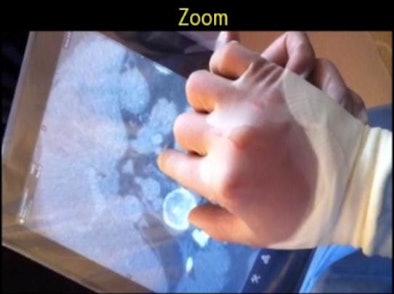 |
| Screenshot demonstrates the Apple iPad for intraoperative imaging review using finger touches and swipes. In this case, the user is employing the zoom function to enhance visualization of the liver lesion. A limited toolbar is at the bottom of the display. |
Prior to the study, the team demonstrated the devices to participating radiologists for one to two minutes. The users then practiced with the devices for two to five minutes until they said they were ready.
Simulation
Participants were then asked to perform a set of five standardized tasks such as scrolling, windowing, and and measuring a liver lesion on the same abdominal CT scan. The participants also ranked each device function on a scale of 1 (lowest) to 3 (highest), resulting in a maximum subjective usability score of 15 points for each device. They were then asked four questions related to the pros and cons of the devices and issues of sterility:
The 29 participating radiologists included 11 (38%) residents, four (26%) fellows, and 14 (48%) attendings. By experience level, 17 (59%) had fewer than 10 years in radiology, while 12 (41%) had 10 or more years in radiology. Nineteen (66%) were ages 20 to 40, nine (31%) were 40 to 60, and one (3%) was older than 60.
While very few of the readers had experience with Kinect or the Loop Pointer, 21 had some or extensive experience with the iPad or iPhone.
The average times to complete the five prescribed tasks were as follows:
- Kinect: 156.7 seconds ± 85
- Loop Pointer: 51.5 seconds ± 30.1
- iPad: 41.1 seconds ± 24.8
A useful intraoperative tool
Sixty-two percent of radiologists felt that the iPad would be useful for intraoperative use, followed by 59% for the Loop Pointer and 55% for the Kinect. In addition, most did not anticipate any problems in maintaining the sterile field, although 10 of the 29 radiologists believed the iPad may have problems maintaining the sterile field.
The average composite usability scores (out of a maximum of 15 points) were 9.9 ± 2.8 for Kinect, 12.9 ± 2.8 for the Loop Pointer, and 13.5 ± 1.8 for the iPad. In other findings, the mean standard deviation from the actual longest dimension of the liver lesion was quite similar across all three devices.
"The Apple iPad had the best usability and accuracy scores, but the Microsoft Kinect had the least concerns for jeopardizing the sterile field," he said. "An ideal device would combine the features of the iPad with the features of the Kinect for not jeopardizing the sterile field."
While the users with prior experience on the Kinect and iPad had faster completion times, these differences were not statistically significant. Faster completion times were also found for users with video game experience, although, with the exception of the Loop Pointer, these differences were also not statistically significant. Computer experience was not a statistically significant factor in task completion times, Chao said.
"Training may improve times with these devices," he said.
Chao acknowledged a number of limitations in the study, including a lack of comparison with current standards of practice, a lack of calculation or estimation of infection, the use of similar but not identical training between participants, and the testing of only one series of tasks.
Future research will focus on optimizing user interfaces, improving and standardizing training, and studying infectious complications, he said.







